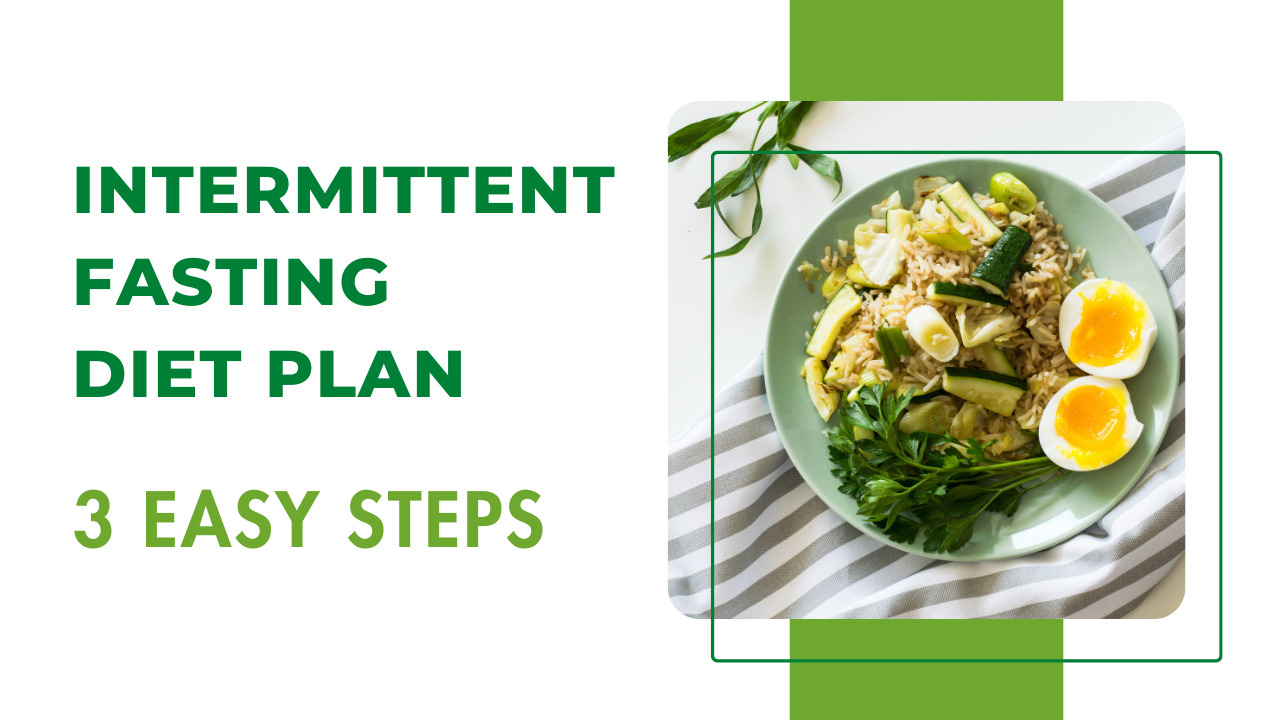Discover how to make your own intermittent fasting diet plan in 3 easy steps that fit your needs and lifestyle. Read Now.
Introduction
Intermittent fasting, a trendy and efficient weight loss strategy, offers a path to shed pounds, boost your well-being, and simplify your daily routine. The basic idea is to switch between eating and fasting, which can happen daily or weekly.
There’s a variety of ways to do it, like the 16/8 method, the 5:2 diet, the warrior diet, and eat-stop-eat. But here’s the cool part: you don’t need to stick to any strict rules. You can create your own Intermittent fasting diet plan that fits your likes, goals, and daily schedule.
Step 1: Choose Your Fasting Window
To make your own intermittent fasting diet plan, the first step is to pick when you won’t eat. We call this your fasting time. During this time, you don’t have any calories.
Now, here’s the fun part: you can choose how long and how often you do this fasting. Some people like doing it for 16 hours every single day, while others do 24 hours once or twice a week. The more you do it and the longer you do it, the more good stuff you’ll get from intermittent fasting.

But, hold on! Don’t forget about your daily life, your schedule, and your health when you decide when to fast. For example, if you have diabetes, low blood pressure, or had trouble with eating in the past, you have to talk to your doctor before you start any intermittent fasting diet plan. Safety comes first, always!
Easy Tips for Choosing Fasting Window
1. Start Small and Grow Gradually
Begin with shorter and less frequent fasting times. When I started, I did a 12-hour fast every day. It was a breeze because I just skipped breakfast and had my regular lunch and dinner. After a few weeks, I bumped it up to 14 hours, then 16, and finally settled at 18 hours. Nowadays, I fast for 18 hours daily and occasionally do a 24-hour fast each week.
2. Fit Fasting into Your Routine
Choose a fasting time that meshes with your daily life and doesn’t mess up your social or work stuff. For instance, if your office takes lunch breaks at noon, maybe start eating at noon and finish at 8 pm.
This way, you can still have lunch with your work buddies and dinner with your family without breaking your fast. Or if you’re a night owl, go for a later start and finish.
Also Read – Lose weight with Enoki Mushroom
3. Try Different Times to See What Clicks
Experiment with various fasting windows to find what suits you best. There’s no one-size-fits-all here. Some people feel more lively in the morning during fasting, while others might get grumpy. Some like more meals, others like bigger ones.
4. Listen to Your Body
Keep an ear out for what your body’s saying and adjust your fasting accordingly. Intermittent fasting shouldn’t feel like a strict diet – it’s more like a flexible way of living that makes you healthier. So, don’t push yourself too hard.
If you’re starving, tired, woozy, or just not feeling right during your fast, it’s okay to break it and grab something good to eat. And if you’ve got any health worries, chat with your doctor before diving into intermittent fasting. Safety first, always!
Also Read – 3 Intermittent Fasting Mistakes and Solutions
Step 2: Choose Your Eating Window
Next up in making your own intermittent fasting plan is picking when you’ll eat. This is basically the time when you can chow down on whatever you like, as long as it matches your daily calorie and nutrition goals.
How long you munch and how often you do it depends on what you like and what your body can handle. Some people go for just one or two meals in their eating time, while others spread it out more during the day.
Now, the shorter and less often you eat during your chosen time, the better chance you have to shed some pounds. But here’s the thing: don’t forget about your hunger, energy, and nutrition needs.
Say you’re super active, expecting a baby, or nursing one, you might need more calories and nutrients compared to someone who’s not so active.
Easy Tips for Choosing Eating Window
1. Pick your Eating Time
First things first, choose a time to eat that gives you the calories and nutrients your body needs. Remember, intermittent fasting isn’t about starving or eating junk. You still want a diet that’s balanced and good for you, with stuff like protein, fibre, healthy fats, vitamins, and all that good stuff.
These things help you stay full, crank up your metabolism, and keep away bad stuff like inflammation and high cholesterol. To figure out how much you should eat, you can use a calorie calculator or a nutrition app. They’ll tell you what’s right based on your age, weight, height, how much you move around, and what you’re aiming for.
2. Your Hunger and Cravings
Make sure your eating time takes care of your hunger and cravings without going overboard. Intermittent fasting can help you get a grip on your appetite and how much you eat each day. But that doesn’t mean you should ignore when you’re hungry or skip the foods you love.

Have a meal when you feel hungry, and quit when you’re no longer really hungry. It’s cool to enjoy your favourite treats in moderation without feeling bad about it. Grab a bite when your stomach grumbles, and pause when you’ve had enough to feel comfortable.
3. Try Things Out
Don’t be afraid to test different eating times and see what clicks for you. Just like with fasting times, there’s no one-size-fits-all for eating times. You might dig to have one big meal a day, or maybe you’re into smaller meals and snacks spread out. Some people like to munch early, others prefer it late.
4. Listen to Your Body
Keep in mind, that intermittent fasting isn’t about locking you into a strict diet. It’s more about having a flexible lifestyle that’s good for your health. So, don’t push yourself to eat more or less than your body wants.
If you’re not feeling hungry during your eating time, no worries, you don’t have to eat. And if you’re still hungry after it’s over, you can keep the munchies going or have something light. But if you’ve got health issues or questions, it’s a smart move to chat with your doctor before you dive in.
Step 3: Choose Your Food Quality
Step three in making your own intermittent fasting plan is all about what you eat. We’re talking about the kind of stuff you eat during your eating time.
Now, intermittent fasting doesn’t force you into any specific diet or tell you to give up certain foods, but it’s still pretty important to think about what’s on your plate. What you put in your belly can impact not just your weight but your overall health too.
So, here’s the deal: try to go for foods that are as close to nature as possible. That means foods that have not been processed too much.
Think of foods full of good things like protein, fibre, healthy fats, vitamins, and minerals. These goodies can keep you feeling full, crank up your metabolism, and keep stuff like inflammation and high cholesterol away.
Easy Tips for Choosing Quality Food
1. Avoid Processed Foods
First off, steer clear of or limit foods that come in packages and are loaded with sugar, salt, trans fats, and all those funky additives and preservatives. These bad boys can mess with your blood sugar, make you extra hungry, slow down your metabolism, and even cause inflammation.

They’re like troublemakers for your health, raising the risk of things like diabetes, heart disease, and even some cancers.
2. Watch Your Drinks
Now, when it comes to sipping, go easy on things like alcohol, coffee, and nicotine. These can mess with the whole fasting thing and dry you up.
They also mess with your sleep, crank up your stress, and mess with your thinking. All of this can cancel out the good stuff you’re trying to do with intermittent fasting. If you do have a drink or a cup of coffee, make sure to drink some water too to stay hydrated.
3. Mix It Up
Don’t stick to the same old food day in and day out. Variety is the spice of life, right? So, make sure you’re eating different stuff from all the food groups – veggies, fruits, grains, protein, dairy, and good fats. Each group has its own speciality that your body needs to stay healthy.

Like veggies and fruits, they pack fibre, vitamins, and antioxidants to keep you healthy. Grains give you energy and help your nervous system. Protein is all about building and repairing your body. Dairy keeps your bones strong, and healthy fats help with hormones and brain smarts.
4. Enjoy Your Food
Lastly, don’t make this whole process a punishment. It’s all about making yourself feel good and healthy. So, eat foods you like and that makes you feel happy.
But remember, it’s not a free pass for junk food all the time. Stick to mostly fresh, real foods that are good for you. But once in a while, go ahead and treat yourself without feeling guilty. It’s all about having a good relationship with your food and not going overboard.
Conclusion: Intermittent Fasting Diet Plan
Intermittent fasting is a cool way to shed some pounds and boost your health. You get to build your very own plan, just the way you like it. All you have to do is pick when you’ll fast, when you’ll eat, and what you’ll eat. It’s all about what works best for you.
So, Follow these three easy steps and you’ve got your personalized intermittent fasting diet plan:
Choose Your Fasting Window: First off, decide when you won’t eat. This is your fasting time, and it’s all up to you. Fit it into your day, your goals, and what feels right.
Choose Your Eating Window: Now, pick when you’ll eat. Your eating time, your rules. Make it work with your schedule, your likes, and your goals.
Watch What You Eat: Last but not least, think about what you put in your belly. Go for stuff that makes you feel good and healthy. But remember, it’s not about going all strict. You can still enjoy your favourite treats now and then without feeling guilty.
Hope this guide helps you make your own intermittent fasting plan super easy. If you’ve got any questions or thoughts, comment below. I’m here to help you on your fasting journey. Thanks for reading, and happy fasting! 😊
*Disclaimer – The information in this article is collected from various resources like online articles, books and magazines. Always consult a healthcare professional or doctor before applying it to your life.
